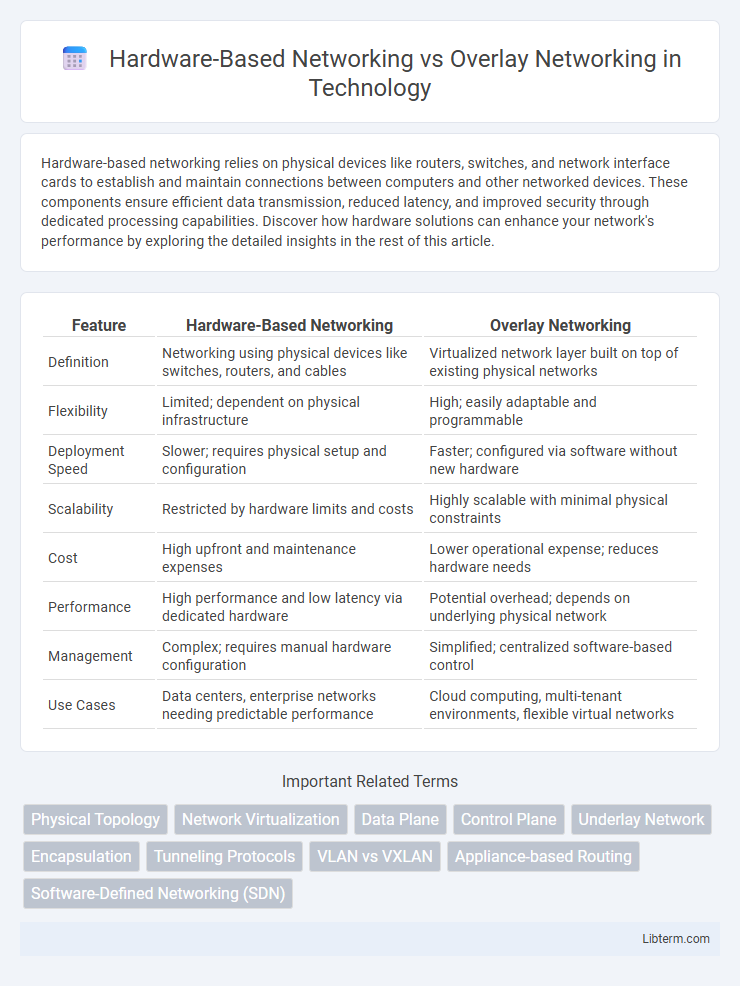Hardware-based networking relies on physical devices like routers, switches, and network interface cards to establish and maintain connections between computers and other networked devices. These components ensure efficient data transmission, reduced latency, and improved security through dedicated processing capabilities. Discover how hardware solutions can enhance your network's performance by exploring the detailed insights in the rest of this article.
Table of Comparison
| Feature | Hardware-Based Networking | Overlay Networking |
|---|---|---|
| Definition | Networking using physical devices like switches, routers, and cables | Virtualized network layer built on top of existing physical networks |
| Flexibility | Limited; dependent on physical infrastructure | High; easily adaptable and programmable |
| Deployment Speed | Slower; requires physical setup and configuration | Faster; configured via software without new hardware |
| Scalability | Restricted by hardware limits and costs | Highly scalable with minimal physical constraints |
| Cost | High upfront and maintenance expenses | Lower operational expense; reduces hardware needs |
| Performance | High performance and low latency via dedicated hardware | Potential overhead; depends on underlying physical network |
| Management | Complex; requires manual hardware configuration | Simplified; centralized software-based control |
| Use Cases | Data centers, enterprise networks needing predictable performance | Cloud computing, multi-tenant environments, flexible virtual networks |
Introduction to Networking Architectures
Hardware-based networking relies on physical devices like routers, switches, and firewalls to manage data traffic, providing high performance and low latency through dedicated infrastructure. Overlay networking uses virtualized layers on top of existing hardware, enabling flexible, scalable, and software-defined network management that abstracts the underlying physical network. These architectures serve distinct purposes: hardware-based networks offer robust, deterministic routing, while overlay networks support dynamic, multi-tenant environments with enhanced programmability.
What Is Hardware-Based Networking?
Hardware-based networking utilizes physical devices such as routers, switches, and firewalls to manage data traffic and establish network connections, providing high performance and low latency. This type of networking relies on dedicated hardware components designed for specific networking functions, ensuring robust security and reliability in enterprise environments. It contrasts with overlay networking, which operates on top of existing infrastructure through software-defined solutions.
What Is Overlay Networking?
Overlay networking is a method of creating virtual networks on top of existing physical infrastructure, enabling enhanced flexibility and scalability without modifying underlying hardware. It uses encapsulation protocols such as VXLAN or GRE to establish isolated, software-defined network segments that abstract physical topology. This approach supports dynamic traffic management, multi-tenant environments, and seamless integration with cloud-native applications, differentiating it from hardware-based networking reliant on physical routers and switches.
Core Differences Between Hardware and Overlay Networks
Hardware-based networking relies on physical devices such as switches, routers, and cables to manage data traffic and ensure low-latency, high-throughput connectivity within a network infrastructure. Overlay networking creates virtualized network layers on top of existing physical networks, using software-defined approaches like VXLAN or SDN to enable flexible, scalable, and programmable network segmentation without altering the underlying hardware. The core difference lies in hardware-based networks emphasizing direct, tangible components for packet forwarding, whereas overlay networks abstract these functions through virtualization for enhanced agility and easier network management.
Performance Comparison: Latency and Throughput
Hardware-based networking delivers superior performance with lower latency and higher throughput by leveraging dedicated physical devices such as switches and routers optimized for packet forwarding. Overlay networking introduces additional encapsulation and software-based processing, resulting in increased latency and reduced throughput compared to hardware-centric solutions. In latency-sensitive and high-bandwidth environments, hardware-based networks are preferred for their minimal packet processing delay and efficient data transmission capabilities.
Scalability and Flexibility Considerations
Hardware-based networking offers high performance and low latency due to dedicated physical devices but can face limitations in scalability and flexibility as expanding infrastructure requires significant investment and physical modifications. Overlay networking provides superior scalability and flexibility by abstracting network functions from physical hardware, enabling rapid deployment, dynamic reconfiguration, and easier integration with cloud environments. Enterprises prioritizing agility and cloud-native applications benefit from overlay solutions, while scenarios demanding maximum throughput and minimal latency may still rely on hardware-based networks.
Security Implications in Both Approaches
Hardware-based networking offers robust physical security by isolating data traffic within dedicated devices, reducing exposure to external threats and minimizing attack surfaces. Overlay networking introduces virtual layers that abstract physical infrastructure, which can lead to increased flexibility but also potential vulnerabilities through software-defined components and centralized control points. Security in overlay networks relies heavily on stringent encryption protocols and authentication mechanisms to safeguard against interception and unauthorized access within shared environments.
Cost Analysis: CapEx vs OpEx
Hardware-based networking demands significant upfront Capital Expenditure (CapEx) due to investments in physical switches, routers, and data center infrastructure, often resulting in higher initial costs. Overlay networking reduces CapEx by leveraging existing hardware and virtualized network functions, shifting expenses towards Operational Expenditure (OpEx) through software licenses, maintenance, and cloud service fees. Over time, overlay networks offer greater cost flexibility and scalability, minimizing maintenance complexity and enabling more efficient resource allocation compared to traditional hardware-dependent setups.
Typical Use Cases and Industry Applications
Hardware-based networking excels in data centers and large enterprises requiring low latency, high throughput, and robust security for mission-critical applications like financial services and telecommunications. Overlay networking is prevalent in cloud computing, DevOps environments, and multi-tenant data centers where flexibility, scalability, and rapid deployment of virtual networks are essential for SaaS providers and service orchestration. Industries such as healthcare and media leverage hybrid models combining hardware and overlay networking to optimize performance and manage dynamic workloads efficiently.
Future Trends in Networking Technologies
Hardware-based networking continues to evolve with innovations such as programmable ASICs and high-speed fiber optics enabling ultra-low latency and increased bandwidth in data centers. Overlay networking leverages software-defined networking (SDN) and network function virtualization (NFV) to provide flexible, scalable, and automated network management across cloud and hybrid environments. Future trends indicate a convergence where hardware acceleration supports overlay architectures, enhancing network performance while enabling granular control and seamless integration with emerging technologies like 5G, edge computing, and AI-driven analytics.
Hardware-Based Networking Infographic

 libterm.com
libterm.com